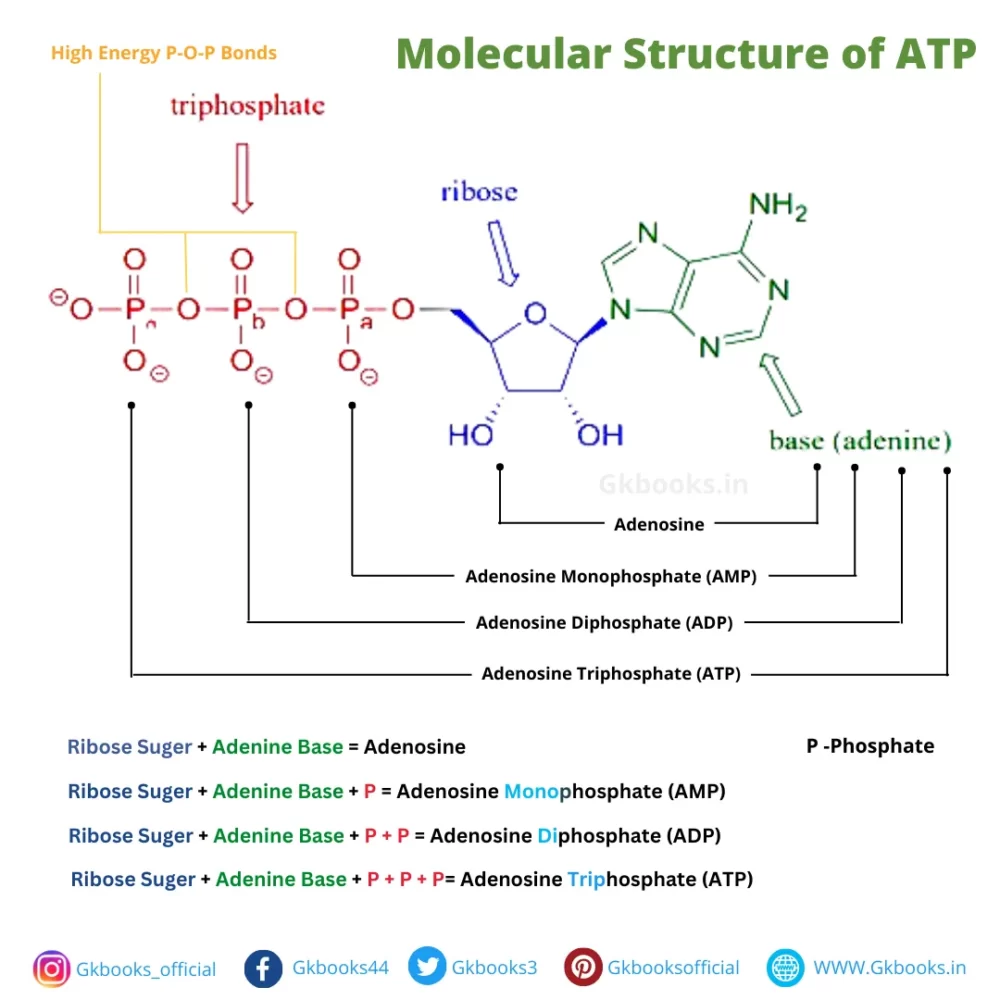Download PDF of “ATP Full Form in Biology“. Here, we provide sufficient details about the ATP Full Form for SSC, RRB NTPC Exam, and all other competitive exams.
What is an ATP Full form in Biology?
• In Biology ATP means Adenosine triphosphate (ATP).
• It is an organic compound that provides energy to carry out many processes in living cells.
• Some vital processes are muscle contraction, nerve impulses, condensation, and chemical synthesis.
• ATP Found in all known life forms, ATP is often referred to as the “molecular unit of currency” of intracellular energy transfer.
Discovery of ATP
• In 1929, German chemist Karl Lohmann discovered the ATP molecule.
• Later in 1948, Scottish biochemist Alexander Todd was the first to synthesize the ATP molecule.
The energy currency of the cell
• Adenosine 5′-triphosphate, or ATP, is also known as the “energy currency” of cells.
Why ATP is called the energy currency
• ATP is the source of energy in a cell to perform various functions such as cell division, respiration, and photosynthesis.
• Also, ATP is required for the synthesis of DNA and RNA.
• ATP is the primary molecule that stores and transfers energy for future use or can be used in response to energy needs.
• Therefore, ATP is called the ‘energy currency of cells.
Component of ATP
• It is an organic compound comprising phosphate groups, adenine, and sugar ribose.
• These molecules provide energy for various biochemical processes in the body.
• Mitochondria synthesize these ATP molecules, therefore it is called the powerhouse of the cell.
Structure of ATP molecule
• An ATP molecule comprises 3 phosphate groups: adenine and ribose sugar.
• These 3 phosphate groups are linked with high-energy bonds.
• Adenine + Ribose Sugar = Adenosine
• Adenine + Ribose Sugar + 1 P = Adenosine Monophosphate (AMP)
• Adenine + Ribose Sugar + 2P = Adenosine Diphosphate (ADP)
• Adenine + Ribose Sugar + 3P = Adenosine Triphosphate (ATP)
Molecular Structure of ATP

How do the ATP molecules produce Energy?
• The three phosphate (triphosphate) groups in the ATP molecule are called high-energy bonds or high-energy P-O-P bonds.
• Hydrolysis of ATP to ADP breaks the P-O-P bonds and releases much energy.
• ATP+H2O → ADP+Pi+ free energy (ATP is hydrolyzed to ADP)
Functions of ATP
• ATP is used to transport various molecules across cell membranes.
• It is also a switch to control chemical reactions and send messages.
• Other functions of ATP include providing the energy needed for blood circulation, muscle contraction, various body movements, and locomotion.
• A significant role of ATP in addition to energy production includes synthesizing the many thousand types of macromolecules necessary for cell survival.
ATP Production
• ATP can be produced through several cellular mechanisms; the three main pathways in eukaryotes are:
- Glycolysis
- TCA cycle
- Beta-oxidation
• TCA cycle or Tricarboxylic acid cycle also called the Citric acid cycle and Krebs Cycle. Each TCA cycle produces 2 ATP.
• In our body, ATP is produced by mitochondria (Power House of Cell), a cellular organelle.
Frequently Asked Questions (FAQ)
Q1. What is the full form of ATP in Biology?
Answer: Adenosine triphosphate (ATP)
Q2. Where is ATP stored in the body?
Answer: Muscle cells
Q3. What produces the most ATP?
Answer: The electron transport chain generates the most ATP.
Q4. How much ATP is produced in the TCA cycle?
Answer: 2 ATPs
Q5. How much ATP is produced in aerobic respiration?
Answer: 38 ATP molecules
Other FULL FORM Topics
For PDF, Print this page and save as a PDFClick the “Print This Page Button”

